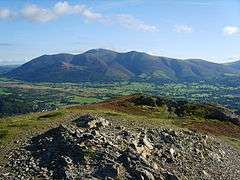Above Derwent
Above Derwent is a civil parish in the Borough of Allerdale in Cumbria, England. It lies entirely within the Lake District National Park.[2]
| Above Derwent | |
|---|---|
 The summit of Barrow | |
 Above Derwent Location within Cumbria | |
| Area | 55.0472 km2 (21.2538 sq mi) [1] |
| Population | 1,198 (2011) |
| • Density | 22/km2 (57/sq mi) |
| OS grid reference | NY231236 |
| Civil parish |
|
| District | |
| Shire county | |
| Region | |
| Country | England |
| Sovereign state | United Kingdom |
| Post town | Keswick |
| Postcode district | CA12 |
| Police | Cumbria |
| Fire | Cumbria |
| Ambulance | North West |
| UK Parliament | |
At the 2011 Census the parish had a population of 1,198 in 514 households,[1] a small decrease from the 2011 figure of 1,207 living in 516 households.[2][3]
The area of the civil parish is 5,505 hectares (13,600 acres; 21.25 sq mi).[1]
History
Above Derwent CP comprised the ancient townships of Braithwaite, Coledale or Portinscale, and Thornthwaite, and the chapelry of Newlands".[4]
The population, according to the 1811 Census, was 668, "rising to 1115 in 1851 and then stable throughout the 19th Century".[4]
Topography
The parish is bounded to the east by Derwent Water, the River Derwent and Bassenthwaite Lake, it includes sections of both lakes. To the West and South, the parish is bounded by the summit of Lord's Seat, the Whinlatter Pass, the summits of Grisedale Pike and Crag Hill, the Newlands Pass, and the summits of Robinson and Catbells.The parish comprises relatively low level land alongside and between both lakes, together with the Newlands Valley, and large areas of the surrounding fells. It includes the settlements of Braithwaite, Thornthwaite, Portinscale, Stair and Little Town.[2] The A66 primary route enters the CP at its most Northerly point, Beck Wythop. The most Southerly point of the CP is approx. 700m south-south-west of Dalehead Tarn.[5]
Governance
Above Derwent has a parish council, the lowest tier of local government in England.[6][7]
Above Derwent falls in the electoral ward of Derwent Valley. The total population of this ward taken at the 2011 Census was 1,615.[8]
The parish is within the Workington constituency of the UK Parliament. As of 2020 it is represented by Mark Jenkinson of the Conservative Party, who was first elected in the 2019 general election
See also
References
- UK Census (2011). "Local Area Report – Above Derwent Parish (E04002379)". Nomis. Office for National Statistics. Retrieved 2 August 2020. Includes map showing parish boundary
- "Election Maps". Ordnance Survey. Archived from the original on 5 January 2010. Retrieved 14 January 2010.
- "Census 2001 : Parish Headcounts : Allerdale". Office for National Statistics. Retrieved 22 November 2009.
- "Above Derwent". Cumbria County History Trust. 2013. Retrieved 22 March 2013.
- http://streetmap.co.uk/idld.srf?x=322508&y=520984&z=120&sv=322508,520984&st=4&mapp=idld.srf&dn=740&ax=322508&ay=520984&lm=0
- "Above Derwent Parish Council". Above Derwent Parish Council. Retrieved 2 August 2020.
- "Parish councils contact information". democracy.allerdale.gov.uk. Allerdale Brough Council. Retrieved 2 August 2020.
- "Derwent Valley ward population 2011". Retrieved 17 June 2015.